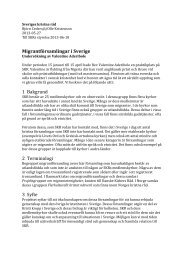Tyngdpunktsförskjutning rapport (PDF) - Sveriges kristna råd
Tyngdpunktsförskjutning rapport (PDF) - Sveriges kristna råd
Tyngdpunktsförskjutning rapport (PDF) - Sveriges kristna råd
You also want an ePaper? Increase the reach of your titles
YUMPU automatically turns print PDFs into web optimized ePapers that Google loves.
from efforts to support individual development and cultivate positive norms in communities to tackling<br />
exclusionary policies, systems and structures that give rise to grievances. Ultimately, a widespread,<br />
inclusive and vibrant engagement within civic life can be the incubator for the institutions and habits<br />
needed to resolve conflict peacefully and generate more responsive and better governance needed to<br />
make peace sustainable.<br />
While it is rare for grassroots efforts to trans-‐form wider systems of conflict and war; it is also not possible<br />
for these wider systems to be transformed without stimulating changes at the community level. Therefore<br />
many analysts and practitioners are agreed with John Paul Lederach’s observation that there is a need to<br />
build peace from the bottom-‐up, the top-‐down and the middle-‐out. 2 Yet the methodologies for crossing the<br />
scale barrier, simultaneously and in a coordinated manner, are not well developed. Therefore the key<br />
seems to be in negotiating dynamic and strategic partnerships.<br />
Primary responsibility for conflict prevention rests with national governments and other local actors. Greater<br />
ownership is likely to result in a more legitimate process and sustainable outcomes. The primary role of outsiders<br />
is to create spaces and support inclusive processes that enable those directly involved to make decisions about<br />
the specific arrangements for addressing the causes of conflict. Outsiders should help to build on the capacities<br />
that exist and avoid actions that displace and undermine homegrown initiatives or that promote short-‐term<br />
objectives at the expense of long-‐term prevention. Based on a collaborative understanding of the sources of<br />
conflict and the factors that continue to generate it, people based elsewhere can seek to address some of the<br />
causes that ‘located’ elsewhere in the conflict system (such as arms suppliers in third countries or policies<br />
promoted by foreign governments that further escalate war).<br />
Partnerships for peace may be the antidote to systems and networks sustaining war. Yet to achieve this<br />
potential, we need to acknowledge the legitimacy of CSOs in peace and security matters and to strengthen<br />
official recognition of their roles in the conflict prevention partnership. This can then be operationalized<br />
through stronger mechanisms and resources for interaction between IGOs, CSOs and governments in order<br />
to institutionalize the capacity for prevention.<br />
It is likely, however, that efforts to shift to a culture of peace and to prioritize prevention over crisis<br />
management will be sustained only when there is widespread awareness amongst the general publics<br />
around the world that common security cannot be obtained through the barrel of a gun; instead, we can<br />
best work towards sustainable peace through collective efforts at meeting basic human needs and<br />
strengthening systems for managing differences peacefully.<br />
37









